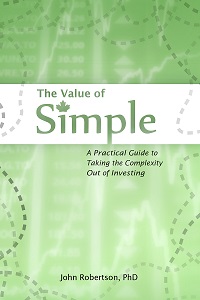Interest Rates and Stock Picks
February 6th, 2008 by PotatoWell, the recent cuts to the bank rates have percolated through to the PC-Financial Interest Plus savings account: down to 3.85% now. That’s not quite as low as the rates have been cut, but it still sucks a little. 4% was a nice psychological number to earn. It gives me more incentive to put my money in the stock market, as soon as I find another stock or two to invest in. (Of course, that’s exactly the response the goblins at the Fed were trying to put in my brain).
Wayfare’s been on my case for gambling via picking stocks. Gambling — addiction to — has been an issue for me that I’ve always kept very tight control of, so she gets (somewhat legitimately) worried when she sees me pore over the market reports in the morning tracking my picks and deciding which to buy, trying to decide if the market has bottomed yet, etc. I get whacked about the ears doubly so because I just did some research about beating the market being a fool’s game, and had a post linking to the great articles on low-cost index mutual funds. I am building a small portfolio of index funds with TD’s e-series funds, but am mostly just putting new money that I manage to save in there. Money that was in individual stocks is being churned back into individual stocks, and money that was in my high interest savings account is being split into individual buying opportunities as well as index funds (with, I’m somewhat sorry to say, most of the money going into individual stocks rather than the funds).
There was a foul run of freezing rain here coating everything in a thick layer of ice, on top of which we got a bit of heavy snow. I went out to scrape my car, and spent nearly an hour just to get part of the windshield done. In that time, over a centimeter of snow had piled up on the parts that had been brushed (but not scraped). I had curling, but after spending that long I just decided to say “fuck it” and stay in (by the time I checked my watch I doubt I could have called a cab to make it on time even if I did want to blow $15 just to make curling). My skip called me from the rink in a foul mood “It doesn’t matter how bad the weather is, they never cancel curling” and asking why I didn’t get a spare. I was at a loss for words, since I was fully intending to go right up until it was too late to get a spare anyway. He hung up in a tiffy, and I lurked about at home in a bit of a funk.
And the stock market was also in a funk this week, dropping nearly 5%, and the week’s not over yet. Despite this drop, and my renewed interest in moving all but the slimmest of emergency buffer out of my PC Financial account, there haven’t been any individual buys that I liked at this point. I’ve been looking particularly at getting something in the oil sector, and have looked at Petro-Canada (PCA) long and hard for a while now. My original price point was $43, which it just touched today, but recent results might force me to rethink that number, so I’m holding off for now. I like Petro-Canada in general, in part because it’s an “integrated” company: they extract oil, refine it, and sell it at retail stations. Sometimes, that might work against them: for instance, while oil extractors are making a killing with high oil prices, there appears to be a bit of a limit in terms of what can be passed along to drivers at the pumps, so refiners and retailers may suffer a bit. This might average out Petro-Canada’s results, but it saves me from having to guess at which particular part of the energy sector will perform well. It also appears (pending my reanalysis) to be a little under-valued relative to some of the other companies such as Imperial Oil (IMO). I’m also considering taking some of the guess work out and getting my oil fix with an exchange traded fund from iShares (XEG). However, that one I don’t think is as bargain-priced at the moment, so I might sit back and wait a while longer.
I did make some small, incremental buys of those TD e-series funds with this dip, buying a tiny bit more of each of the 4 indexes I’m using: the Canadian, US (S&P500), Dow Jones Industrial, and International. At the moment, I haven’t put a huge amount of thought into how I want to allocate things there, since there is plenty of time to rebalance later. I’m basically going with a nearly even split between them all, which would make my US part about twice as big as the Canadian and International parts. I think that for sure the US part should be bigger than the Canadian one as long as the individual-stock-picking part of my portfolio is already largely (nearly exclusively) Canadian. In the longer run, I will probably aim to have them be about equal. I think, academically, that the international index should be just about as big as the US components combined to get good global weighting (or complemented by another international index such as a “BRIC” ETF), but the markets are volatile as it is, and the international index is even more so, which has turned me off a tiny bit. I still don’t have a bond fund component, which is another post in its own right.
Priszm (QSR.UN), which I mentioned 2 weeks ago hasn’t really moved anywhere. It’s still yielding a very attractive 19%, though there is a good chance that will be reduced somewhat: my guess is it will get cut to about 15%, based on the current price of about $6.35. That’s still pretty good looking though. My dad and I can’t quite figure out why it hasn’t taken off on this news. There was a huge sell-off from a single broker last week, what my dad terms an “iceberg order”. It is so named because there is a huge amount of stock to be sold, but you only ever see a small part of it on the market at a given time, with the rest lurking just below the surface. This one broker kept putting up small lots of shares at the same price — as soon as one lot sold, he put up another one, keeping the price down. No real way to know if it was a mutual fund bailing out of it, or what the story was. Anyhow, that seems to be over, but the price just hasn’t moved since then.
Another income trust to look at is Teranet (TF.UN). They’re yielding a conservative 8% at the moment. This is a company that collects the Ontario and Toronto land transfer taxes, earning royalties from those activities which it pays out to unit holders. Now, the Toronto land transfer tax collection deal was only mentioned a few days ago, and it’s not clear how much more they’ll collect in terms of royalties, let alone whether city council will stick with the tax (they can’t seen to make up their minds about a budget in the slightest lately). The stock jumped up to about $10.25 on the news, and then a few days later dropped back down to the $9.75 range. Now, part of that drop appears to be an analyst’s report released that said Teranet was at risk of cutting their distribution since it represented over 90% of its cash flow. My dad noticed a mistake in the analyst’s math: he was using the wrong figure for cash flow/income, and the payout ratio is really only about 70%. That might signal a potential increase in the distribution to come, or give them a buffer in case of an economic problem. Speaking of which, I can’t make up my mind about how recession-proof this company is. On the one hand, they make money from any housing transfer, even a foreclosure (or so I am lead to believe), no matter if the price is astronomical or busy crashing. However, I worry that there may be a volume issue — my dad disagrees. It should be a relatively safe harbour for an 8% return anyway, especially with some extra revenue to come from the city of Toronto and a bit of a buffer in their payout ratio.
As always, a standard disclaimer that I’m not a financial advisor, I’m not very experienced in matters financial, and that if you do let my ramblings (so-called since they can hardly be construed as advice) on stock market issues percolate into your brain and you somehow lose money, don’t blame me.


 Questrade: use QPass 356624159378948
Questrade: use QPass 356624159378948 Passiv is a tool that can connect to your Questrade account and make it easier to track and rebalance your portfolio, including the ability to make one-click trades.
Passiv is a tool that can connect to your Questrade account and make it easier to track and rebalance your portfolio, including the ability to make one-click trades.